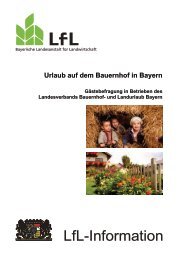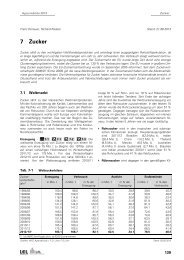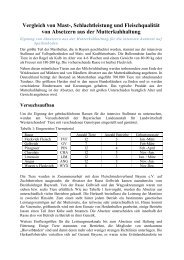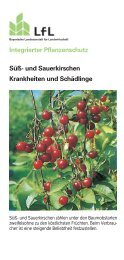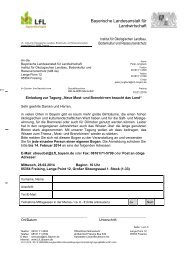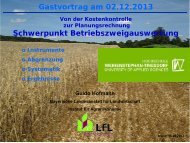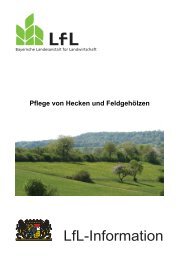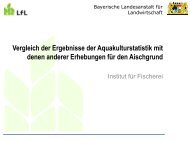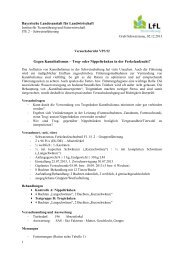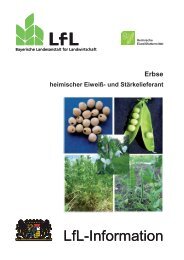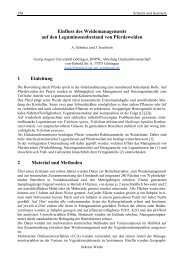production of powdery mildew resistant hops via gene - CiteSeerX
production of powdery mildew resistant hops via gene - CiteSeerX
production of powdery mildew resistant hops via gene - CiteSeerX
Create successful ePaper yourself
Turn your PDF publications into a flip-book with our unique Google optimized e-Paper software.
PRODUCTION OF POWDERY MILDEW RESISTANT HOPS VIA GENE TRANSFER<br />
H. Miehle, E. Seigner<br />
Bayerische Landesanstalt für Landwirtschaft, Institut für Pflanzenbau und Pflanzenzüchtung,<br />
IPZ 5c, Am Gereuth 8, 85354 Freising, Germany;<br />
E-mail: helga.miehle@LfL.bayern.de<br />
Abstract<br />
The chitinase <strong>gene</strong> HCH1 deriving from the <strong>powdery</strong> <strong>mildew</strong> <strong>resistant</strong> hop cultivar ‘Zenith’<br />
was inserted into the genomes <strong>of</strong> two <strong>powdery</strong> <strong>mildew</strong> susceptible hop cultivars by<br />
Agrobacterium-mediated transformation. Transgenic hop plants were confirmed using PCR<br />
and RT-PCR. First tests for resistance to <strong>powdery</strong> <strong>mildew</strong> revealed that the transgenic <strong>hops</strong><br />
carrying the chitinase <strong>gene</strong> showed enhanced levels <strong>of</strong> resistance.<br />
Keywords: hop <strong>powdery</strong> <strong>mildew</strong>, resistance, chitinase, <strong>gene</strong>tic engineering<br />
Introduction<br />
Genetic engineering is an innovative strategy to improve disease resistance. An approach<br />
most widely used was to over-express pathogen related (PR) proteins such as chitinases.<br />
Plants constitutively expressing different is<strong>of</strong>orms <strong>of</strong> chitinase <strong>gene</strong>s showed enhanced<br />
resistance to various fungal diseases. For example increased resistance to <strong>powdery</strong> <strong>mildew</strong><br />
could be achieved by the expression <strong>of</strong> a class I rice chitinase <strong>gene</strong> in strawberry and in<br />
grapevine plants (Asao, et al., 1997; Yamamoto et al., 2000).<br />
A class I chitinase (HCH1) precursor deriving from the PM <strong>resistant</strong> English hop cultivar<br />
‘Zenith’ was identified by Henning and Moore (1999) based on its homology to a pea<br />
endochitinase <strong>gene</strong>. Due to its specific sequence it was suggested that this HCH1 <strong>gene</strong> may<br />
be involved in the resistance reaction <strong>of</strong> cv. ‘Zenith’ to <strong>powdery</strong> <strong>mildew</strong>.<br />
Here we show the successful stable transformation <strong>of</strong> two different PM susceptible hop<br />
cultivars ‘Hallertauer Mfr.’ and ‘Saazer’ expressing the endochitinase <strong>gene</strong> HCH1 deriving<br />
from the PM <strong>resistant</strong> hop variety ‘Zenith’ to enhance resistance to hop <strong>powdery</strong> <strong>mildew</strong><br />
Podosphaera macularis ssp. humuli <strong>via</strong> <strong>gene</strong>tic engineering.<br />
Material and Methods<br />
To induce the transcription <strong>of</strong> the hop endochitinase <strong>gene</strong>, plantlets <strong>of</strong> in vitro grown ‘Zenith’<br />
have been infected with a specific strain <strong>of</strong> Podosphaera macularis. Seven to ten days after<br />
incubation at room temperature the in vitro infested plants were harvested, placed in liquid<br />
nitrogen and ground thoroughly with a mortar and pestle. RNA extraction followed with the<br />
RNeasy Plant Mini Kit (Qiagen) as described by the producer.<br />
In total three PCR primer pairs were designed complementary to the sequence <strong>of</strong> the hop<br />
endochitinase HCH1 <strong>gene</strong> (Henning and Moore, 1999) to meet specific requirements<br />
(Tab. 1). For the RT-PCR reaction from ‘Zenith’-RNA primer pair A was deployed. 1 µg <strong>of</strong><br />
total RNA was reversely transcribed and the cDNA was amplified through a one step<br />
RT-PCR reaction with Super Script Platinum Taq (Invitrogen) as described by the supplier<br />
using the following cycling conditions: RT 1 cycle - 50°C - 30 min; PCR 1 cycle - 94°C -<br />
2 min, 40 cycles – 94°C – 30 sec – 55°C – 30 sec – 72°C – 1 min, 1 cycle 72°C – 7 min.<br />
Re-amplification <strong>of</strong> the resulting PCR fragment was performed with a Pwo Polymerase<br />
(Roche) by adding an additional guanidine base to each <strong>of</strong> the 3’-ends <strong>of</strong> both primers and<br />
by raising the annealing temperature to 57°C (primer pair B). This amplicon was then subcloned<br />
into the pGEM-T vector (Promega) and suitable restriction sites were attached to the<br />
cloned HCH1 cDNA by another PCR reaction deploying primer pair C (upper primer with<br />
5’-EcoRI restriction site and lower primer with 5’-BamHI restriction site). The annealing<br />
temperature was finally raised to 66-68°C. This PCR reaction yielded 2-3 bands. The 948-bp-<br />
1
2<br />
band was cut out <strong>of</strong> the agarose gel and cleaned up with QiaExII Gel Extraction Kit (Qiagen).<br />
For a proper cleaving efficiency close to the termini <strong>of</strong> the PCR fragments a further subcloning<br />
step into a pGEM-T vector (Promega) was performed. To ensure an accurate cDNA<br />
sequence the amplicons were repeatedly sequenced (MWG Biotech).<br />
Table 1: List <strong>of</strong> PCR primers for the amplification and detection <strong>of</strong> the HCH1 <strong>gene</strong> applied to RT-PCR<br />
<strong>of</strong> cv. ‘Zenith’ (primer pair A), re-amplification and detection <strong>of</strong> trans<strong>gene</strong>s by PCR and RT-PCR<br />
(primer pair B) and attachment <strong>of</strong> restriction sites (primer pair C).<br />
primer<br />
pair A<br />
primer<br />
pair B<br />
primer<br />
pair C<br />
upper primer lower primer<br />
5’ atgaagaagtggtgtattattgt 3’ 5’ ctagccgaaaggagtttgatt 3’<br />
5’ atgaagaagtggtgtattattgtg 3’ 5’ ctagccgaaaggagtttgattg 3’<br />
5’ gaattcatgaagaagtggtgtattattgtg 3’ 5’ ggatccctagccgaaaggagtttgattg 3’<br />
The resulting HCH1 cDNA now including the appropriate restriction sites was finally cloned<br />
into a CaMV 35S promoter. Subsequently, the promoter-HCH1-construct was cleaved with<br />
HindIII and introduced into a binary vector. Indirect <strong>gene</strong> transfer into ‘Saazer’ and cv.<br />
‘Hallertauer Mittelfrüh’ was obtained by co-cultivation with Agrobacterium tumefaciens for 2<br />
to 3 days as described previously (Seigner et al., 2005). After two weeks selection for<br />
transgenic re<strong>gene</strong>rating tissue was started using 25 mg/l kanamycin as medium additive.<br />
The insertion <strong>of</strong> the HCH1 cDNA into the hop genome and the presence or absence <strong>of</strong><br />
Agrobacteria were confirmed by a duplex PCR in one single reaction with primer pair B<br />
(Tab. 1) and another primer pair specific for the agrobacterial sequence <strong>of</strong> virG (upper<br />
primer, 5’ gccgacagcacccagttcac 3’, and lower primer, 5’ gccgtaagtttcacctcacc 3’; LAG,<br />
1999). The PCR reaction was performed as follows: 1 cycle - 94°C - 4 min, 40 cycles –<br />
94°C – 1 min – 57°C – 2 min – 72°C – 2 min, 1 cycle 72°C – 7 min with the HotStarTaq DNA<br />
Polymerase (Qiagen) yielding a fragment <strong>of</strong> 948 bp and 380 bp, respectively. As positive<br />
controls for the amplification <strong>of</strong> the HCH1 cDNA and the virG sequence the cDNA/T-vector<br />
construct and the agrobacterial strain were deployed, respectively. The applied negative<br />
controls were: wild-type ‘Saazer’ DNA, wild-type ‘Hallertauer Mfr.’ DNA and the ‘water<br />
control’ (no template DNA).<br />
Transgenic plants were tested for their resistance towards <strong>powdery</strong> <strong>mildew</strong> in vitro using the<br />
detached leaf assay (Seigner et al., 2002). Detached young leaves <strong>of</strong> in vitro grown<br />
transgenic plantlets were placed on water-agar plates and inoculated with conidia <strong>of</strong> two<br />
specific monosporic isolates (BU10 and BU13) <strong>of</strong> Podosphaera macularis deriving from the<br />
Hallertau hop growing region. These PM strains revealing virulence <strong>of</strong> the v3, v4, v6, and vB<br />
type can infect hop plants carrying the complementary R <strong>gene</strong>s (R3, R4, R6, and RB) and<br />
susceptible plants with no resistance <strong>gene</strong> at all (Seigner et al., 2002). In vitro grown leaves<br />
<strong>of</strong> ‘Zenith’ (resistance based on R1 <strong>gene</strong>) being <strong>resistant</strong> towards PM isolate BU10 and BU<br />
13 and non-transgenic `Saazer` being susceptible to all PM pathotypes were used as<br />
negative and positive control plants, respectively. Seven to ten days after inoculation under<br />
standardized incubation conditions growth <strong>of</strong> PM was assessed on the hop leaves.<br />
Results<br />
Putative transgenic plants from both cultivars were tested for the integrated chitinase <strong>gene</strong><br />
using the duplex PCR. Based on strict PCR conditions the integration <strong>of</strong> the HCH1 <strong>gene</strong><br />
could be confirmed in fifteen ‘Saazer’ and three ‘Hallertauer Mfr.’ plants (Fig. 1), while nontransformed<br />
control plants from cv. ‘Saazer’ and ‘Hallertauer Mfr.’ did not show such a
fragment. The simultaneous test for persisting Agrobacteria in the duplex PCR reaction by<br />
adding virG specific primers yielded negative results in all tested cultivars (Fig. 1). Thus, it<br />
could be proved that the HCH1 cDNA is stably integrated into the plant genome and that the<br />
duplex PCR amplicon does not result from plasmids <strong>of</strong> persisting Agrobacteria.<br />
virG HCH MI 1 2 3 4 5 6 MII nc nc<br />
Furthermore, a successful transcription <strong>of</strong> the HCH1 <strong>gene</strong> has been confirmed in all <strong>of</strong> the<br />
transformed hop plantlets by RT-PCR as well (data not shown).<br />
Finally the transgenic plants were tested for PM resistance using the in vitro detached leaf<br />
assay. Two different PM strains were used for the artificial inoculation. Seven to ten days<br />
after inoculation with PM spores vigorous growth <strong>of</strong> the mycelium could be observed on the<br />
leaves <strong>of</strong> non-transgenic plants <strong>of</strong> ‘Saazer’ and ‘Hallertauer Mfr.’, while no infection appeared<br />
on leaves <strong>of</strong> ‘Zenith’. A more differentiated reaction towards PM could be seen on the leaves<br />
<strong>of</strong> the transgenic ‘Saazer’ and ‘Hallertauer Mfr.’plants. Some plants showed the same<br />
susceptibility as the non-transgenic control plants, but on the leaves <strong>of</strong> two HCH1 carrying<br />
<strong>hops</strong> reduced growth <strong>of</strong> the mycelium could be observed indicating an enhanced resistance<br />
to PM (Fig. 2).<br />
Discussion<br />
1031 bp<br />
500 bp<br />
Fig. 1: Duplex PCR for the detection <strong>of</strong><br />
HCH1 and virG <strong>gene</strong> sequences in<br />
transformed ‘Hallertauer Mfr.’ and ‘Saazer’<br />
plants<br />
virG = virG Agrobacterium (pos. control)<br />
380bp<br />
HCH = HCH1 construct (pos. control)<br />
948bp<br />
1-3 = transgenic ‘Hallertauer Mfr.’<br />
4-6 = transgenic ‘Saazer’<br />
nc = wildtype ‘Hallertauer Mfr.’ and<br />
‘Saazer’ (neg. control)<br />
MI = 1-kb-marker<br />
MII = 100-bp-marker<br />
Fig. 2: Detached leaf assay <strong>of</strong> three<br />
HCH1 transgenic in vitro grown<br />
‘Saazer’ plants performing various<br />
degrees <strong>of</strong> resistance towards<br />
<strong>powdery</strong> <strong>mildew</strong>.<br />
Regarding fungal resistance, Punja (2004) summarizes the various approaches to enhance<br />
resistance to fungal diseases in different crops. Besides the expression <strong>of</strong> pathogen-related<br />
proteins and antimicrobial compounds the most widely used approach was to over-express<br />
the various is<strong>of</strong>orms <strong>of</strong> chitinase, among the hydrolytic PR proteins. Thus, a class I hop<br />
endochitinase (HCH1) has been chosen and applied in this study as it is suggested to be<br />
involved in the resistance reaction <strong>of</strong> cv. ‘Zenith’ to <strong>powdery</strong> <strong>mildew</strong>.<br />
3
4<br />
Eighteen HCH1 transgenic plants have been produced in total. The stable <strong>gene</strong> integration<br />
was proved by duplex PCR and the expression could be confirmed by RT-PCR. This is the<br />
first time that transgenic ‘Hallertauer Mfr.’ could be re<strong>gene</strong>rated successfully. Reports<br />
published so far are restricted to the re<strong>gene</strong>ration <strong>of</strong> transgenic plants <strong>of</strong> ‘Tettnanger’<br />
(Horlemann et al., 2003; Schwekendiek et al., 2005), and ‘Saazer’/’Oswald Clone’<br />
(Oriniakova and Matousek, 1996; Okada et al., 2003). Already performing tissue culture <strong>of</strong><br />
the wild-type ‘Hallertauer Mfr.’ is challenging and its poor re<strong>gene</strong>ration ability even declines<br />
after Agrobacterium infection and in the presence <strong>of</strong> antibiotics. Therefore, fully grown GUS<br />
expressing plants could not be obtained. In contrast to this, transgenic ‘Hallertau Mfr.’ plants<br />
bearing the chitinase <strong>gene</strong> revealed increased vigor at a very early stage during the<br />
re<strong>gene</strong>ration process. Thus, it may be assumed that this additional HCH1 <strong>gene</strong> positively<br />
affected the vigor and re<strong>gene</strong>ration ability <strong>of</strong> this cultivar.<br />
Finally, using the detached leaf assay reduced growth <strong>of</strong> specific PM strains on the leaves <strong>of</strong><br />
transgenic plants was observed. This is the first successful approach to enhance resistance<br />
to hop <strong>powdery</strong> <strong>mildew</strong> Podosphaera macularis <strong>via</strong> <strong>gene</strong>tic engineering in <strong>hops</strong>.<br />
Based on these very promising results further investigations on other <strong>gene</strong>s conferring fungal<br />
resistance will follow.<br />
Acknowledgements<br />
We wish to thank the Bavarian State Ministry for Agriculture and Forestry for funding this<br />
work. Special thanks are due to Dr. Friedrich Felsenstein and Stefanie Hasyn, Epilogic<br />
GmbH, Freising, for their cooperation in all tests with hop <strong>powdery</strong> <strong>mildew</strong>.<br />
References<br />
Asao, H., Nishizawa, Y., Arai, S., Sato, T., Hirai, M., Yoshida, K., Shinmyo, A., and Hibi, T., 1997:<br />
Enhanced resistance against a fungal pathogen Sphaerotheca humuli in transgenic strawberry<br />
expressing a rice chitinase <strong>gene</strong>. Plant Biotechnol. 14, 145-149.<br />
Henning, J.A., and Moore, D.L., 1999: Humulus lupulus endochitinase precursor (HCH1) <strong>gene</strong>. NCBI<br />
database, AF147497.<br />
Horlemann, C., Schwekendiek, A., Höhnle, M., and Weber, G., 2003: Re<strong>gene</strong>ration and<br />
Agrobacterium-mediated transformation <strong>of</strong> hop (Humulus lupulus L.). Plant Cell Rep 22, 210-217.<br />
LAG Länderausschuss Gentechnik, 1999: Nachweis von persistierenden Agrobakterien in trans<strong>gene</strong>n<br />
Kulturpflanzen und deren mikro- und molekularbiologische Charakterisierung. In:<br />
Methodensammlung des LAG; Unterausschuss Methodenentwicklung, 23.11.1999.<br />
http://www.hamburg.de/<br />
Behoerden/Umweltbehoerde/gen/oeffentlich/methodensammlung/AGROBAK.PDF<br />
Okada, Y., Saeki, K., Inaba, A., Suda, N., Kaneko, T., and Ito, K., 2003: Cloning and expression <strong>of</strong><br />
valerophenone synthase promotor. I.H.G.C. Proceedings <strong>of</strong> the Scientific Commission ISSN<br />
1814-2206, Dobrna-Žalec, Slovenia 24 –27 June 2003, 73-77.<br />
Oriniakova, P. and Matousek, J., 1996: Viroid infection <strong>of</strong> hop (Humulus lupulus L.) mediated by<br />
Agrobacterium tumefaciens and conditions for hop transformation. Rostl. Výr. 52, 233-239.<br />
Punja, Z.K., 2004: Genetic engineering <strong>of</strong> plants to enhance resistance to fungal pathogens. In: Z.K.<br />
Punja (ed.), Fungal disease resistance in plants, 207-258. Haworth Press Inc.<br />
Seigner, E., Lutz, A., Radic-Miehle, H., Seefelder, S., Felsenstein, F.G., 2005: Breeding for <strong>powdery</strong><br />
<strong>mildew</strong> resistance in hop (Humulus): Strategies at the Hop Research Center, Huell, Germany.<br />
Acta Hort 668, 19-30. http://www.actahort.org/books/668/668_1.htm.<br />
Seigner, E., Seefelder, S. and Felsenstein, F., 2002: Untersuchungen zum Virulenzspektrum des<br />
Echten Mehltaus bei Hopfen (Sphaerotheca humuli) und zur Wirksamkeit rassen-spezifischer<br />
Resistenz<strong>gene</strong>. Nachrichtenbl. Deut. Pflanzenschutz. 54, 147-151.<br />
Schwekendiek, A., Horlemann, C., Spring, O., Stanke, M., Höhnle, M., and Weber, G., 2005: Hop<br />
((Humulus lupulus L.) Transformation with Stilbene Synthase for Increasing Resistance against<br />
Fungal Pathogens. Acta Hort 668, 101-107.<br />
Yamamoto, T., Iketani, H., Ieki, H., Nishizawa, Y., Notsuka, K., Hibi, T., Hayashi, T. and Matsuta, N.,<br />
2000: Transgenic grapevine plants expressing a rice chitinase with enhanced resistance to fungal<br />
pathogens. Plant Cell Rep 19, 639-646.



